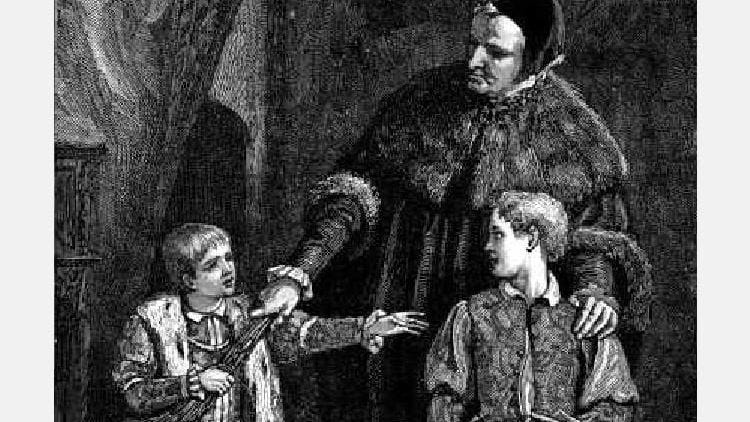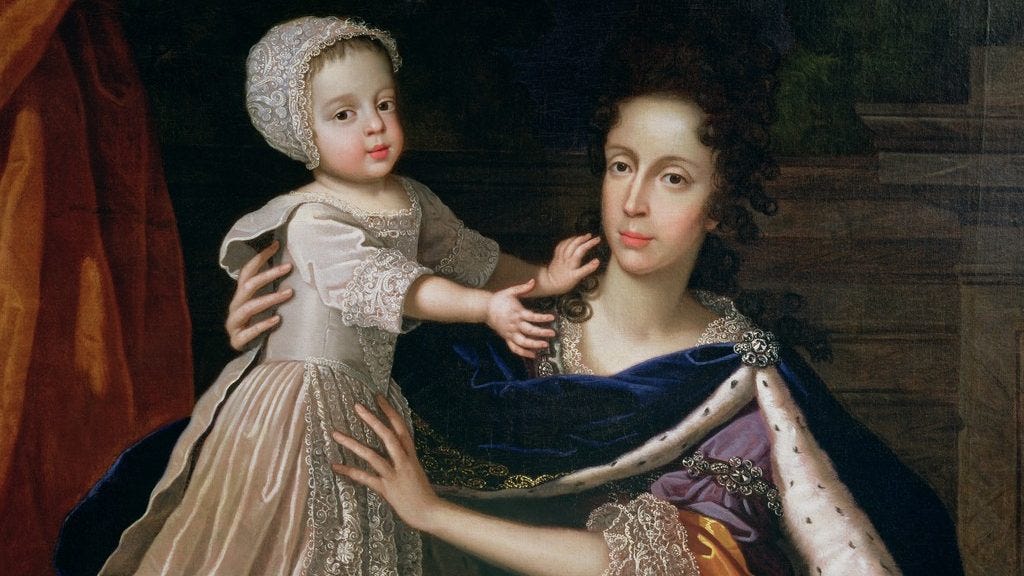Scapegoat.
Today, we use that term to describe people who symbolically take on the sins of others, or who are blamed for things that someone else has done.
But the term ‘scapegoat’ has an even longer and more disquieting history. It was first coined in 1530 to describe a literal goat who, in the Biblical Book of Leviticus, had its horns wrapped in red cloth (representing the community's sins). The goat would then be driven off into the wilderness. In even older Jewish tradition, the goat would have been slaughtered or thrown from a cliff in atonement for humanity’s sins.
We, on the whole, don’t literally sacrifice living things to atone for our sins anymore. But if you’re looking to find a similar practice still in action, a good place to start is with the royals. They’ve been getting away with it for years.
Welcome to Off With Her Head, a newsletter series from The Fascinator, which is a new writing medium that I want to try out as a way to avoid routinely publishing mile-long tirades on Substack. In these installments, we’re examining the lives of women who have been the subjects of blatantly biased treatment throughout history.
This first installment—outlining what royal scapegoating entails—is free for all readers, but subsequent parts will be for paid subscribers only. Thank you for continuing to support my writing and make this work sustainable!
This practice of royal scapegoating can, of course, happen in many different ways. But even if it hasn’t always been intentionally done on the part of the royals themselves, they have always benefitted from it.
For many centuries, for example, it was considered treason to openly and directly criticize the sovereign or monarchy itself—a crime called lèse-majesté. (In some places, like Thailand, this is still criminalized behavior). To register displeasure, then, royal subjects could instead set their sights on a person close to the king or queen to denounce in their place.
Sometimes, as we’ll see in this series, the monarch could recognize what was happening and come to that person’s defense. But it was also equally possible, and perhaps more likely, that they would simply continue to allow undesirable attention and abuse to fall on that unlucky individual—rather than shouldering it themselves.
Women, in particular, have been used to deflect from the failings of monarchs in many different ways over the ages—as have (sadly) children. What follows in this series will be a deep dive into some instances of royal scapegoating from history, and why it’s happened in each case.
I’ll leave you with two of royal history’s most famous examples in this installment.
Remember, subsequent newsletters in this series will be exclusively available for paid subscribers of the Fascinator!
Whipping Boys: Fact or Fiction?
If you’ve read a lot of historical fiction, you might be familiar with the idea of a “whipping boy.” In early modern Europe, this would have been a child brought into the royal sphere to become friends with a prince. This child—usually a commoner—would eat, sleep, play, and attend lessons with the royal youngster. They would be equals, for all intents and purposes, but if or when the prince disobeyed the royal tutor, the jig would be up.
The idea was that a mere teacher or tutor could not lay a finger on a prince, so he would instead whip the prince’s friend in his presence, “in the hopes that the emotional trauma would be enough to force the prince to follow orders.”
Today, most historians agree that the existence of whipping boys is largely the stuff of myth and rumor. But believing that the practice existed doesn’t require a substantial stretch of the imagination.
Even if whipping boys weren’t really a thing, I do think that the broader concept here has merit: the royal circle has never had any qualms about sacrificing the wellbeing of an outsider in order to protect their own.
Mary of Modena and the Warming Pan Scandal
The 1600s may not be where you expected me to start, but Mary of Modena, queen consort to James II of England and VII of Scotland, is a perfect introduction to royal scapegoats.
Now, James was straight-up not a popular monarch; he was Roman Catholic at a time when most of his subjects had fully embraced the Protestant Reformation. There was a sliver of hope on the horizon, however: James was due to be succeeded by his Protestant daughters, Mary and then Anne. Their late mother, Anne Hyde, had been an Anglican who converted to Catholicism—although Mary and Anne were brought up in the Church of England by order of their uncle, King Charles II.
James married his second wife, the 15-year-old Catholic Mary of Modena, hoping to produce a male (and also Catholic) heir who could inherit instead of James’ two daughters. This was enough to set the public on edge; they had no desire to be plunged back into a cultural tug-of-war between the Catholic and Protestant faiths.
Mary of Modena was pregnant ten times from 1674-1684, but each of these children was either stillborn or died young. When Mary became pregnant again in 1687, for the first time in several years, James’ subjects became, true to form, seriously concerned about the possibility of an imminent Catholic heir to the throne. But because of the 4-year gap between this pregnancy and Mary’s last one, there was also speculation that the pregnancy was a fake.
James’ younger daughter, the future Queen Anne, went so far as to speculate with friends that her step-mother, Mary, wore a fake belly. Many others followed suit.
With the stage set for a royal scandal, when baby James Francis Edward was born on June 10th, 1688, doubt was immediately cast about whether he was the legitimate son of James II and Mary of Modena. Although prominent government officials were present in the room to witness the birth of England’s heir, Protestant nobles quickly spread a rumor that the baby boy had been stillborn. In their version of events, another child had been smuggled into Mary’s birth chamber—inside a warming pan—to take the stillborn baby’s place, ensuring that there would, no matter what, be a Catholic heir to the throne.
With so many eyes upon her at all times, the thought that Mary of Modena could have faked a pregnancy or carried out a baby swap is next to impossible. But the rumors swirled so fiercely that James called on over 70 eyewitnesses to sign affidavits stating that they viewed a live birth.
But the damage was done. The rumors about baby James Francis Edward’s illegitimacy were readily accepted and spread by those eager to undermine the Catholic King’s hold on power.
James’ Protestant daughters Mary and Anne also promoted the conspiracy theory, claiming that their new replacement in the line of succession was illegitimate and a changeling. Just over a year after the birth, Princess Mary’s husband, William of Orange, was invited by Protestant English nobles to invade England. He landed with troops on English shores in November 1688, kicking off the Glorious Revolution and forcing King James and Mary of Modena into exile.
Implications
As a royal consort’s primary goal is to provide heirs for the country, casting doubts on the legitimacy of their children is a surefire (and perhaps the quickest) way to undermine their place within the institution. By extension, then, the legitimacy of their royal spouse can be called into question—without a word actually needing to be said about them.
It’s not a far stretch to glimpse shades of the Warming Pan Scandal in some more modern “theories” about one royal wife in particular. Eerily similar conspiracies have been loudly crowed online about each of Meghan Markle’s pregnancies.
If you’re not familiar, first of all, count yourself lucky. Every accusation in the book has been lobbed at the Duchess of Sussex when it comes to her children with Prince Harry—from charges that she employed a surrogate, wore a fake belly, and even purchased a doll or borrowed an actual infant for use in photo ops.
None of these claims have any basis in reality, but the goal of perpetrators of this type of gossip and harassment is never to bring the “truth” to light. It is simply to diminish Meghan’s role as the wife of a Prince, to treat her with contempt, and to reduce, by association, Harry’s own contribution to the line of succession.
I’ll put it more bluntly. In these deranged perpetrators’ view, if Prince Archie and Princess Lilibet were no longer considered “heirs of the body” in the most literal sense (meaning that they were not physically born from Meghan’s body) then the line of succession could skip Harry and Meghan’s children entirely. These are the first biracial children born into the British Monarchy’s F line of succession, just so we’re clear about motivations here.
Prince Harry himself, you’ll note, almost never figures in these conspiracies. It’s usually “Meghan’s nastiness, Meghan’s scheming, Meghan’s narcissism, Meghan’s hubris” that you’ll find referenced to inspire these deluded fantasies.
Contemporary parallels
The Duchess of Sussex is, in the words of author and historian Kate Williams, just the most recent proof that “women who marry into the royal family are made to suffer, attacked for their appearance; family; the work they do; the lives they have lived before.”
Meghan has suffered a uniquely terrible blend of sexist, xenophobic, classist, and racist criticism. She’s even been the subject of an endless barrage of odious headlines seeking to pit her against her sister-in-law, future queen Kate Middleton. Now there’s a story with parallels: the media attempted the same trick when Sarah Ferguson and Diana Spencer both occupied places in the Firm.
Before Meghan’s day, though, every other woman who married into the Firm had also been subject to lesser degrees of scrutiny by way of initiation. Kate was ritually “mocked and her family criticized,” Sarah Ferguson was called the “Duchess of Pork,” and Diana’s every move was, of course, endlessly dissected.
Later in this series, with historical precedent in mind, we’ll consider how modern royal women have been crucified by age-old sexist tropes in the quest to prop up the monarchy. Spoiler alert: as outsiders, they are still viewed as expendable in the neverending quest to sustain the allure of the Crown.
But first, we’ll go back in time a bit farther, examining the lives of (and lies about) royal women of yore. I’m sad to say that there are echoes of the same tropes from across time.
The sad truth is that biographers, tabloid reporters, and royal commentators have fallen prey to these tricks so readily for centuries, to the point that I doubt some of them even realize the system that they are a part of. One has to wonder whether this pattern will ever be broken—or indeed, as it’s been perpetuating itself for almost a thousand years, whether it even can be.
I hope you’ll join me on this exploration of royal scapegoating throughout history. I can’t say that it’s a fun topic to dive into, but I do believe it to be a vital one to unpack and unlearn. Along the way, we’ll meet notable Queens of the past—like Marie Antoinette and Isabeau of Bavaria—and also get reacquainted with royal women from our own time.









Fascinating stuff!
👏 👏👏👏 here for this!!!